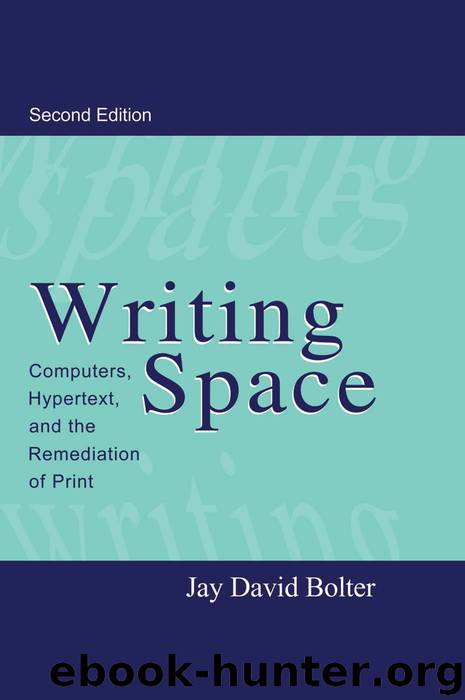Writing Space: Computers, Hypertext, and the Remediation of Print by Jay David Bolter

Author:Jay David Bolter [Bolter, Jay David]
Language: eng
Format: epub
ISBN: 9781135679538
Publisher: Taylor and Francis
Published: 2001-01-01T05:00:00+00:00
FIG. 6.1. A Web page from WebCrossing, a program for asynchronous discussion by teachers and students.
The CMC [computer-mediated communication] technology creates a distinctly unique social context in which participants are actively employing reading and writing strategies required for participation in the exchange … [P]articipants are receiving immediate written reactions to their messages that they can read and reflect on (Beach & Lundell, 1998, p. 95).
Although this technology can mediate discussions on topics in traditional literary history or other disciplines, many teachers of writing like to use it to examine the politics of identity through the lenses of race, gender, and class. MOOs and chat rooms seem well-suited to exploring the issue of postmodern identity, perhaps because the student must construct her identity solely through her words. (= > p. 198) Beth Kolko writes that “[t]he MOOs power lies in our ability as educators to make students aware of how the characteristics of their situated selves inform their virtual decisions … [I] t is by using MOOs to examine the reified relations of identity and power in real space … that the educational use of MOO as an object lesson in politics becomes most articulated.… Ultimately the MOO with its lessons in play, partiality, and situatedness holds a particular power to teach us about our bodies, our place, and our politics” (Kolko, 1998, pp. 259, 260, 263).
In addition to environments for synchronous and asynchronous discussion, educators have developed hypertextual applications to remediate such forms as the anthology, commentary, and textbook. One of the best examples is The Victorian Web (www.stg.brown.edu/projects/hypertext/landow/victorian/victov.html July 1, 1999), a hypermedia textbook, created by George Landow, who has pioneered the use of hypertext to “reconfigure” education in English literature (Landow, 1997, pp. 219–266). Now offered as a Web site, The Victorian Web has grown out of materials developed since the 1980s on a variety of networked systems. It is an archive of primary sources, essays on primary sources, and images—a database to which students as well as Landow himself and other experts have contributed texts and links. It is the capacity of hypertext for collective writing and growth that grounds the claim of The Victorian Web to an immediacy not available in most printed textbooks. In reflecting the concerns and insights of many contributors, including the students who use it, this Web site ushers students into the kind of exchange that professional scholars conduct when they share ideas at conferences and through journal papers. The same advantage is offered by Landow’s Postcolonial Literature Web (www.stg.brown.edu/projects/hypertext/landow/post/misc/postov.html July 1, 1999) and other pedagogical sites. Such sites constitute hypertextual writing as a cooperative effort, which is designed to overcome the barriers of authority that separate professors from students in the traditional classroom.
When we write for the Web, cultural expectations invite and ultimately demand that we use multimedia. Although primarily textual, The Victorian Web includes numerous images in its archive: for example, images of women in Pre-Raphaelite painting and a gallery of paintings by John William Waterhouse. This form of hypertextbook
Download
This site does not store any files on its server. We only index and link to content provided by other sites. Please contact the content providers to delete copyright contents if any and email us, we'll remove relevant links or contents immediately.
Sass and Compass in Action by Wynn Netherland Nathan Weizenbaum Chris Eppstein Brandon Mathis(7969)
Supercharging Productivity with Trello by Brittany Joiner(7337)
Mastering Tableau 2023 - Fourth Edition by Marleen Meier(7109)
Inkscape by Example by István Szép(6981)
Secrets of the JavaScript Ninja by John Resig Bear Bibeault(6739)
Visualize Complex Processes with Microsoft Visio by David J Parker & Šenaj Lelić(6667)
Build Stunning Real-time VFX with Unreal Engine 5 by Hrishikesh Andurlekar(5690)
Design Made Easy with Inkscape by Christopher Rogers(5007)
Customizing Microsoft Teams by Gopi Kondameda(4547)
Business Intelligence Career Master Plan by Eduardo Chavez & Danny Moncada(4451)
Extending Microsoft Power Apps with Power Apps Component Framework by Danish Naglekar(4158)
Salesforce Platform Enterprise Architecture - Fourth Edition by Andrew Fawcett(4019)
Pandas Cookbook by Theodore Petrou(4012)
Linux Device Driver Development Cookbook by Rodolfo Giometti(4010)
The Tableau Workshop by Sumit Gupta Sylvester Pinto Shweta Sankhe-Savale JC Gillet and Kenneth Michael Cherven(3821)
Exploring Microsoft Excel's Hidden Treasures by David Ringstrom(3300)
TCP IP by Todd Lammle(3120)
Applied Predictive Modeling by Max Kuhn & Kjell Johnson(3006)
Drawing Shortcuts: Developing Quick Drawing Skills Using Today's Technology by Leggitt Jim(2980)
